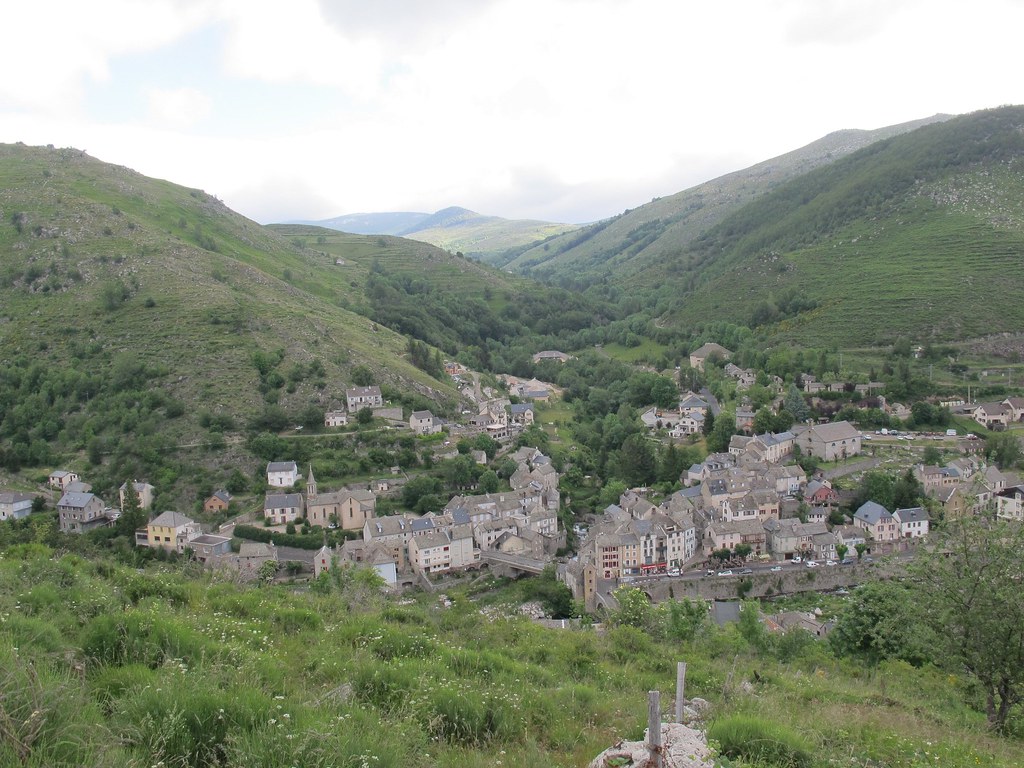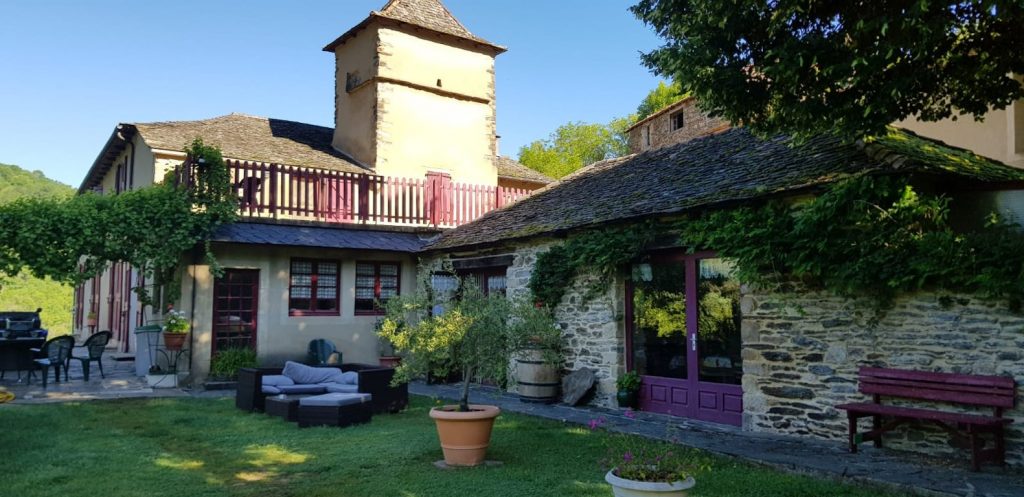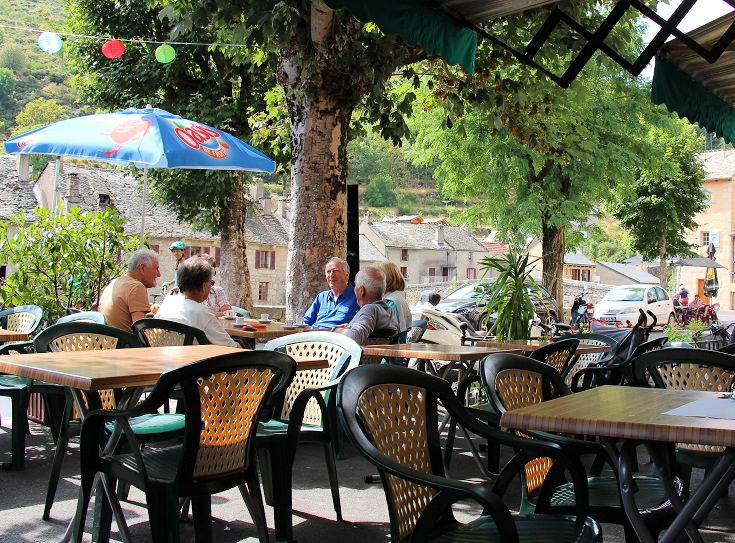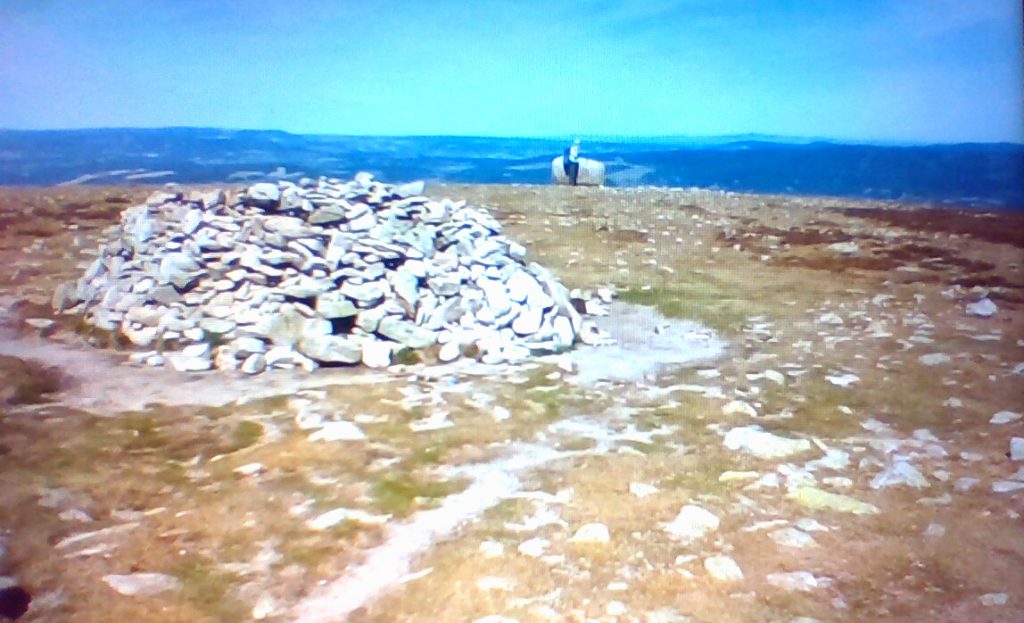* * * *

* * * *
In the last post we hiked down to Saint-Germain-de-Calberte, on October 1, “What turned out to be a really eventful and awe-inspiring day.” That left only two more days hiking on the Chemin de Stevenson; first, “an easy 5.5 miles to Saint-Étienne-Vallée-Française, then another 8.1 miles to the end, Saint-Jean-du-Gard.” If all went according to plan we’d get to St. Jean on Tuesday, October 3, “145 years to the day after Stevenson ended his journey.” (Though his journey ended in Alès, some 34 miles east of St. Jean. We’d be taking a bus to Alès on October 5.)
I started that October 2 with a note back home on Facebook, with a picture: “Good morning, ‘Sunrise over the Cevennes!'” I added that we were supposed to have a short hike, and that hopefully it would be “nice and boring, smooth level path all the way.” Later I added that it was a fairly smooth hike, and that we “ended up at basically an old castle, high atop a hill in St. Etienne Vallee Francaise. Built entirely of rock. You’d think there wouldn’t be any rocks left over for the Stevenson Trail, BUT THERE WERE! And rocks o’ plenty. But seriously, a spectacular place to stay. Medieval, and definitely not your Motel 6.”
Getting there we saw more locals along the way, out hunting for the mushrooms that seem to be a favorite pastime. (Like back in my college days?) Also, strangely, we hiked through a lot of what seemed to be tropical rain forest, complete with stands of bamboo and “ferns aplenty.”
Our goal was Le Château de Cambiaire, Saint-Étienne-Vallée-Française, and you can see it from miles away. But how to get there? A river – Le Gardon de Saint Martin – runs along the main drag, “D984,” leading into town. But to get to the chateau you have to get off the main road and on to a side road, “Le Meyran,” with a turn that comes way before you get into town. From there it weaves back and forth up a steep hill to where that road splits, and there you have to get on a side-lane, “St.-Etienne Val Franc Bourg.” Then hike up another hill to the chateau
Still, we got there in good time, by 2:00 in fact, then faced a slight problem. You can’t check in until 3:00, which led to “Lots of waiting around.” Fortunately the place had a bar, in a side building, and after waiting patiently a while, sitting at an outside picnic table and being observant, I saw a man who seemed to be part of the staff coming in and out. After a bit he went in again and I followed, then managed to persuade him – with sign language and some pointing-of-fingers – to pour me a draft. From there I was happy and went on to “wax poetic.”
Sitting at a picnic table, looking out over the light-speckled green valley below, I got out my pocket notebook and started scribbling, a la Hemingway. I first noted the hike was a “milk run of sorts. Left the apartment at 10:10″ and from there a “veggie store” in Saint-Germain at 10:21. We ended up officially checking in at the chateau at 3:35, because of a delay of sorts. Of the setting I later wrote: “Neat old place. Medieval, dark-paneled wood. The guys’ room (BR) in the turret of this old towered place.” I wrote that part of my ode to the place while “sitting with a Stevenson blonde beer, looking out over the valley, three mountains on the horizon.” Then this:
Tomorrow, last day hiking. Thoughts of home? 8.1 miles to go… What have I learned? Have I developed? I think there’s a book in this. Too! Like the other adventures. Zen moment here, “Tasting the breeze!” – Grazing horse down below. Soft Cevennes sunlight. Soft breeze. Moments like this make the plodding, plugging along for hours, sore feet and all, all worthwhile.
So much for stream of consciousness, but in time I got a little antsy. And as it turned out, dinner wasn’t until much later. (We weren’t exactly sure.) So at 6:30, needing a break, I hiked back down the hill and along the river, of which I wrote later. “Going down I heard kids. They were down by the water tossing rocks in. I could hear them way up, leaving the chateau.” A pleasant enough interlude, watching them do what I used to do as a kid, but then came some drama.
“Right by the city-enter sign, two heavy-armed gendarmes. Impressive, dark blue trousers light blue shirts. Like bad-ass Air Force dudes. I tried my hardest not to look suspicious. Like a doofy harmless American tourist? I dreaded the chilling ‘May I see your papers please?'” The thing was, they didn’t seem to have any reason to be there. Just standing around. Which brought to mind something I’d read in Travels with Charley. John Steinbeck described coming back into the US from Canada, being stopped at the border and asked, “Please step into the office.”
This request had the effect on me a Gestapo knock on the door might have. It raises panic, anger, and guilty feelings whether or not i have done wrong. My voice took on the strident tone of virtuous outrage which automatically arouses suspicion.
I certainly didn’t want that to happen. (And I had had those two beers.) But nothing happened. I made good and sure to walk up the road far enough not to look like I was turning and heading back just because I saw them. (Talk about raising suspicion.) Then made it back to the chateau, where I sat at a picnic table and started jotting again. And this: “At 6:50 p.m. the bar guy just came by. Nice guy! Very attentive! Brought a Stevenson out to my picnic table with a little Petri dish kind of thing with pretzels.” Later still I added, “I love sitting here, or in a Paris sidewalk cafe, scribbling away, like I’m Hemingway or something. Tom just came out of the room. I directed him to how to get a beer. And we reminisced.” Of old times, back when we were kids.
And finally, to dinner, in the ancient wall-of-stone dining room seen below. (But you know, packed with pilgrims?) Along with the usual complimentary big bottles of shared wine, a full three-course meal. For some reason I didn’t write about the first course, but the second was a “combination salad, veggie bowl, lots of rice and two local-made sausage links. (‘Erp!’) But good.” Then came the dessert, “A very rich dessert, with whipped cream and like a graham cracker crust on the bottom.” (And another good time was had by all.) Which led me to observe:
These three and four course dinners late at night are killing me! (Plus wine of course.) At home I usually don’t eat after 6:00, and then only a salad. I dread that first weigh-in Monday morning, October 9.
But all that would come later. Meanwhile, tomorrow is our last hiking day, to St. Jean du Gard. Then a day or two later we head back to Paris, where apparently they were having a plague of bed bugs. (“Oh thank you, France!”) But hopefully that’s not on our future agenda.
* * * *
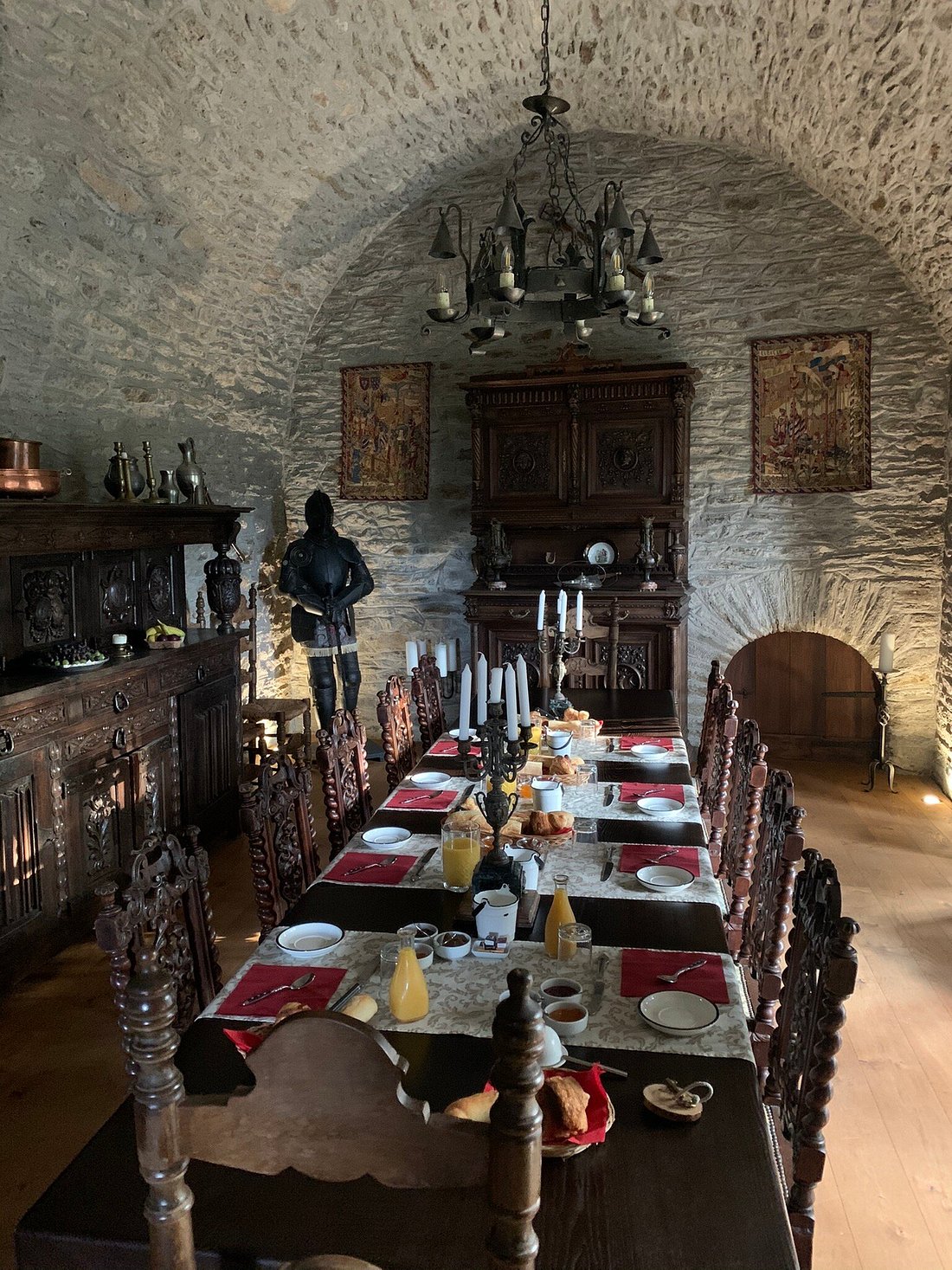
* * * *
The upper image is courtesy of Le Château de Cambiaire, Saint-Étienne-Vallée-Française, our goal that October 2. And to those who might say this place did not fit the term, see Castle – Wikipedia:
A castle is a type of fortified structure built during the Middle Ages predominantly by the nobility or royalty and by military orders. Scholars usually consider a castle to be the private fortified residence of a lord or noble.
Re: Milk run. According to Wikipedia it has multiple meanings, including that during World War Two especially, for United States Army Air Corps and Royal Air Force crews, a milk run was a “military air mission posing little danger.”
Re: “Tasting the breeze!” A phrase from my nephew-by-marriage, describing his son – my great-nephew – in a swing, going back and forth, eyes closed, thoroughly enjoying himself.
The Steinbeck quote is at page 86 of my Penguin Paperback version. He tried an end-run, to “creep along the neck of Ontario,” thus bypassing heavy traffic in Cleveland and Toledo.
Re: Bed bugs in Paris. See 2023 Paris bedbug infestation – Wikipedia. And apparently the city is having another this year, Bedbug panic sweeps Paris as infestations soar before 2024 Olympics. Which means this is a good year to go to Spain.
The lower image is courtesy of CHÂTEAU DE CAMBIAIRE – Prices & B&B Reviews (Tripadvisor).
* * * *

